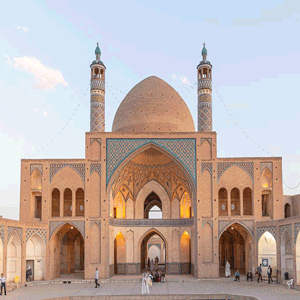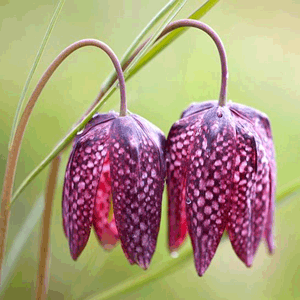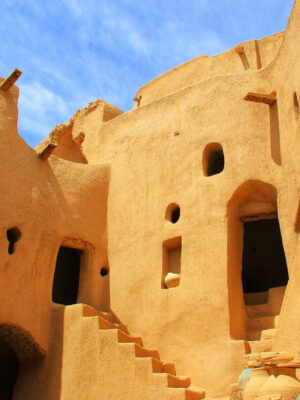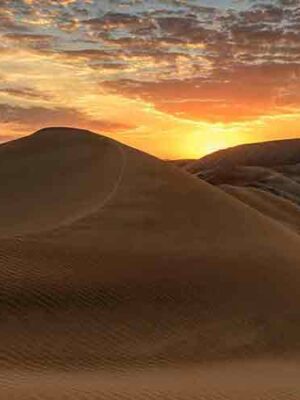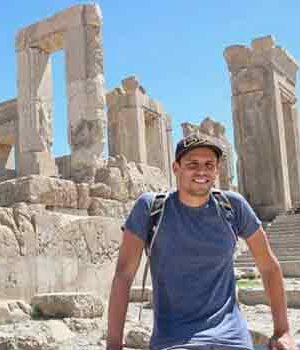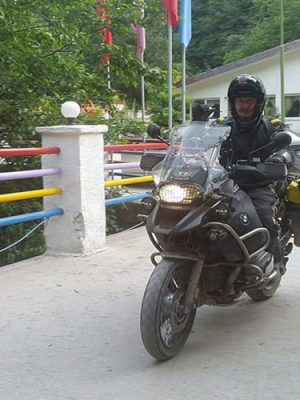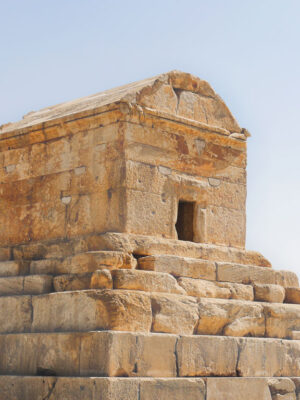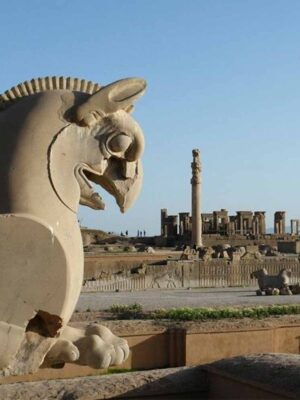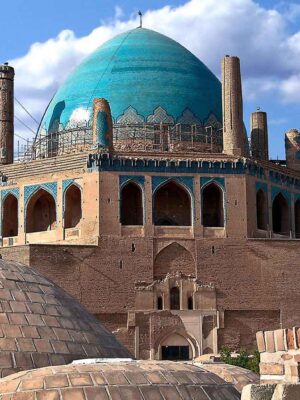Travel to Iran at the time of Ashura
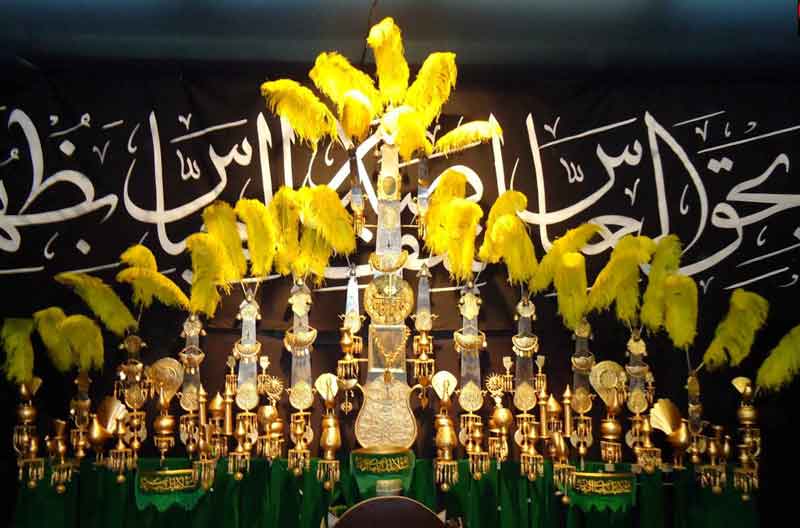 Heavy standard used in Ashura ceremonies and parades
Heavy standard used in Ashura ceremonies and parades
The Iranians do not perform many rituals as wholeheartedly as Ashura. During Ashura, they decorate the streets with banners and give away food and drinks. They blow horns and recite songs to the rhythm of drums and people of all ages get together in large groups to watch and participate in spectacular religious processions.
Is Ashura Celebrated?
Ashura is basically not a festival to celebrate, but a collection of religious rituals that are observed to commemorate the 3rd Shia Imam who was martyred in Karbala in the late 7th century AD. It is actually the climactic end of a mourning tradition that starts on the 1st day of Muharram, in the Hijri lunar calendar, and lasts for 10 days.
During these 10 days, after sunset and the evening prayers, you will see local people, young and old, men and women, going out to the energized streets and performing rituals together, as they beat on their chests and move with the rhythm of drums in parades. There are heavy standards that precede parades. The mourners decorate these huge artifacts with jingling bells and feathers. One strong man carries each standard on his own. After marching for a couple of hours, processions return to places called Husseiniehs to continue with the rituals in circles and in masses, moving and mourning to the drum beats and the rhythmic lamentations.
History of Ashura
In the late 7th century AD, Shimr-Ibn-Alzeijushan martyred Hussein-Ibn-Ali, the 3rd Shia Imam in Karbala. Hussein was fighting a battle against the Umayyad’s army. After the war, Shiite followers recounted and lamented the events as a historical epic that gradually formed a collection of ceremonies and rituals that became an indispensable part of Shiism. The rituals gained significant status in Iran at the time of 17th-century Safavids as the government declared Shiism as the official religion of the country. In modern Iran, Ashura is now a part of Islamic identity that brings people together to be a part of one big event.
Nazri
Although Ashura ceremonies are in fact mourning traditions, you will find people to be quite lively as they enthusiastically participate in high-spirited activities. Nazri is one of the most well-known of these traditions, which is basically distributing food to people as charity. There are times when a Muslim makes a vow to God that if his wish comes true, he will give away a certain amount of money or food as a votive (Nazri) to people, and Muharram is the perfect opportunity to fulfill such promises.
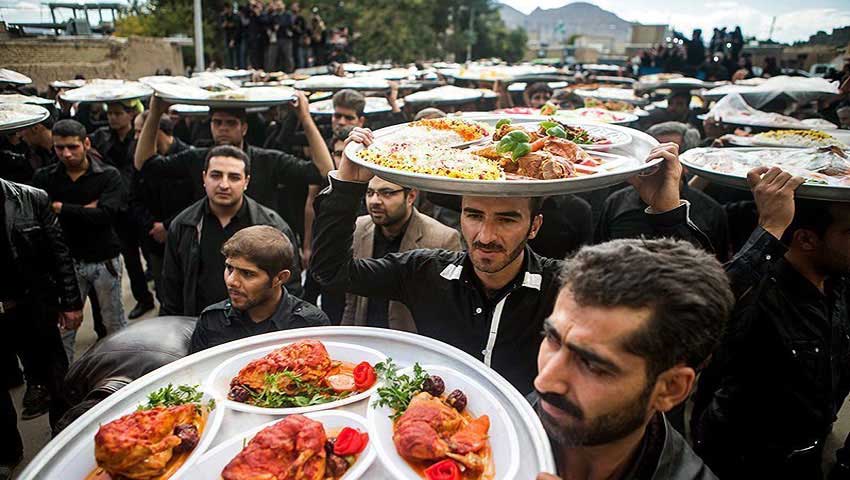 Iranians distributing free food, called Nazri, to people as charity
Iranians distributing free food, called Nazri, to people as charity
Iranians serve hot tea or cold sherbet to participants and spectators on the streets. But the most customary Nazri dish in the month of Muharram is Khoresht Gheymeh. It is a stew that includes rice, lamb, split peas, and other ingredients. Volunteers prepare Gheimeh in huge casseroles and give it away to people. As a matter of fact, giving and receiving a free meal on this occasion is a fun part of Muharram for a lot of Iranians who consider this food a gift from God and the 3rd Shia Imam and they believe it to be good for their body and soul.
Nakhl-Gardâni
In some parts of Iran, on the occasion of Ashura, people carry a huge wooden structure called Nakhl. It symbolizing Imam Hussein’s coffin. Some of these wooden objects are so gigantic, that only a hundred strong men can carry one on their shoulders!
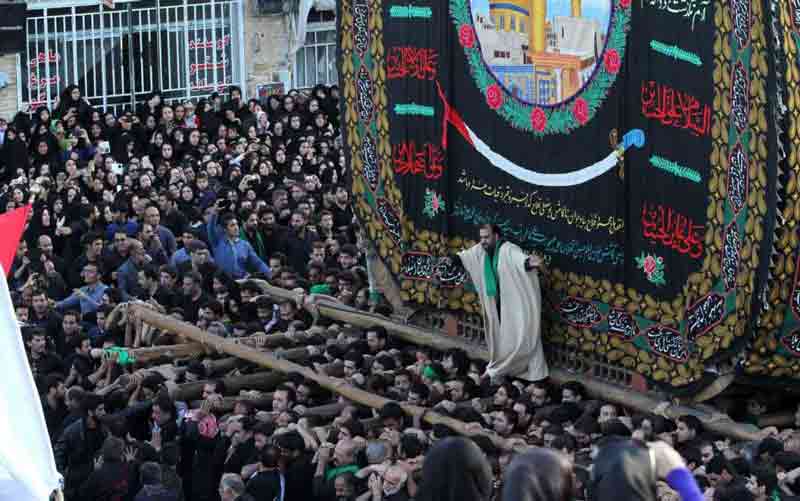 People carrying Nakhl on their shoulders as a symbol of 3rd Shiite Imam’s coffin
People carrying Nakhl on their shoulders as a symbol of 3rd Shiite Imam’s coffin
The rite of Nakhl-Gardâni dates back to pre-Islamic times when Iranians held a similar ritual called Siavashoon for a mythological character called Siavash. The most famous Nakhlgardani rituals in Iran happen in the city of Yazd and the village of Abyaneh.
Ta‘zīye (Shabih-Khâni)
Ta‘zīye is a theatrical reenactment of Imam Hussein’s martyrdom in Karbala. Religious actors perform Ta‘zīye in open spaces and grand squares. They recount the story of the battle in an epical manner with people singing and acting in dramatic manners. In some performances, there are more than a hundred roles to play and animals are also a part of the spectacle. UNESCO declared Ta‘zīye or Shabih-Khâni as an Intangible Cultural Heritage of Humanity in 2010.
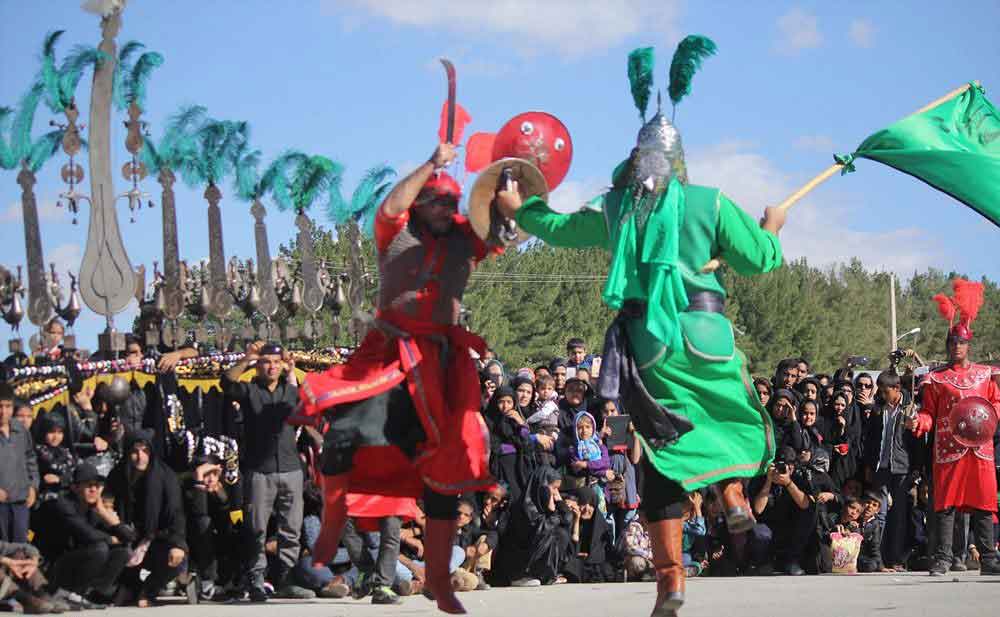 Actors performing a traditional play in Ashura ceremonies
Actors performing a traditional play in Ashura ceremonies
Shâm-e-Qaribân
At noontime of the 10th day in Muharram, the rituals reach their climax. At this time almost all participants are out, marching in parades. They distribute food and drinks and watch Ta‘zīye. After lunch, things go back to a calm public holiday, but it is not the end of the ceremonies. Participants, especially the young, get ready for the evening and a ceremony of Shâm-e-Qaribân. In this ceremony, Iranians light candles on the streets in memory of the 3rd Shia Imam and his followers. This occasion is relatively calm and peaceful, as you see youths wearing black and holding candles in their hands. As midnight arrives, people have finished the ten-day mourning ceremonies in a sacred serenity.
More about Iran:
Travel to Iran at the time of Ashura
 Heavy standard used in Ashura ceremonies and parades
Heavy standard used in Ashura ceremonies and parades
The Iranians do not perform many rituals as wholeheartedly as Ashura. During Ashura, they decorate the streets with banners and give away food and drinks. They blow horns and recite songs to the rhythm of drums and people of all ages get together in large groups to watch and participate in spectacular religious processions.
Is Ashura Celebrated?
Ashura is basically not a festival to celebrate, but a collection of religious rituals that are observed to commemorate the 3rd Shia Imam who was martyred in Karbala in the late 7th century AD. It is actually the climactic end of a mourning tradition that starts on the 1st day of Muharram, in the Hijri lunar calendar, and lasts for 10 days.
During these 10 days, after sunset and the evening prayers, you will see local people, young and old, men and women, going out to the energized streets and performing rituals together, as they beat on their chests and move with the rhythm of drums in parades. There are heavy standards that precede parades. The mourners decorate these huge artifacts with jingling bells and feathers. One strong man carries each standard on his own. After marching for a couple of hours, processions return to places called Husseiniehs to continue with the rituals in circles and in masses, moving and mourning to the drum beats and the rhythmic lamentations.
History of Ashura
In the late 7th century AD, Shimr-Ibn-Alzeijushan martyred Hussein-Ibn-Ali, the 3rd Shia Imam in Karbala. Hussein was fighting a battle against the Umayyad’s army. After the war, Shiite followers recounted and lamented the events as a historical epic that gradually formed a collection of ceremonies and rituals that became an indispensable part of Shiism. The rituals gained significant status in Iran at the time of 17th-century Safavids as the government declared Shiism as the official religion of the country. In modern Iran, Ashura is now a part of Islamic identity that brings people together to be a part of one big event.
Nazri
Although Ashura ceremonies are in fact mourning traditions, you will find people to be quite lively as they enthusiastically participate in high-spirited activities. Nazri is one of the most well-known of these traditions, which is basically distributing food to people as charity. There are times when a Muslim makes a vow to God that if his wish comes true, he will give away a certain amount of money or food as a votive (Nazri) to people, and Muharram is the perfect opportunity to fulfill such promises.
 Iranians distributing free food, called Nazri, to people as charity
Iranians distributing free food, called Nazri, to people as charity
Iranians serve hot tea or cold sherbet to participants and spectators on the streets. But the most customary Nazri dish in the month of Muharram is Khoresht Gheymeh. It is a stew that includes rice, lamb, split peas, and other ingredients. Volunteers prepare Gheimeh in huge casseroles and give it away to people. As a matter of fact, giving and receiving a free meal on this occasion is a fun part of Muharram for a lot of Iranians who consider this food a gift from God and the 3rd Shia Imam and they believe it to be good for their body and soul.
Nakhl-Gardâni
In some parts of Iran, on the occasion of Ashura, people carry a huge wooden structure called Nakhl. It symbolizing Imam Hussein’s coffin. Some of these wooden objects are so gigantic, that only a hundred strong men can carry one on their shoulders!
 People carrying Nakhl on their shoulders as a symbol of 3rd Shiite Imam’s coffin
People carrying Nakhl on their shoulders as a symbol of 3rd Shiite Imam’s coffin
The rite of Nakhl-Gardâni dates back to pre-Islamic times when Iranians held a similar ritual called Siavashoon for a mythological character called Siavash. The most famous Nakhlgardani rituals in Iran happen in the city of Yazd and the village of Abyaneh.
Ta‘zīye (Shabih-Khâni)
Ta‘zīye is a theatrical reenactment of Imam Hussein’s martyrdom in Karbala. Religious actors perform Ta‘zīye in open spaces and grand squares. They recount the story of the battle in an epical manner with people singing and acting in dramatic manners. In some performances, there are more than a hundred roles to play and animals are also a part of the spectacle. UNESCO declared Ta‘zīye or Shabih-Khâni as an Intangible Cultural Heritage of Humanity in 2010.
 Actors performing a traditional play in Ashura ceremonies
Actors performing a traditional play in Ashura ceremonies
Shâm-e-Qaribân
At noontime of the 10th day in Muharram, the rituals reach their climax. At this time almost all participants are out, marching in parades. They distribute food and drinks and watch Ta‘zīye. After lunch, things go back to a calm public holiday, but it is not the end of the ceremonies. Participants, especially the young, get ready for the evening and a ceremony of Shâm-e-Qaribân. In this ceremony, Iranians light candles on the streets in memory of the 3rd Shia Imam and his followers. This occasion is relatively calm and peaceful, as you see youths wearing black and holding candles in their hands. As midnight arrives, people have finished the ten-day mourning ceremonies in a sacred serenity.
More about Iran:






